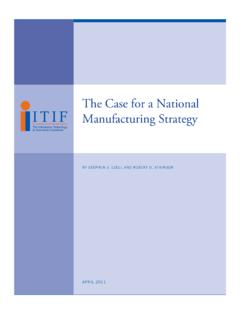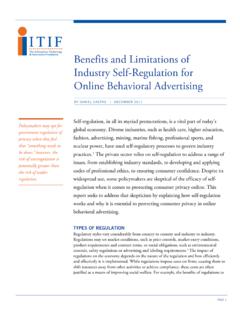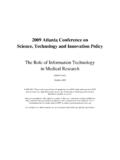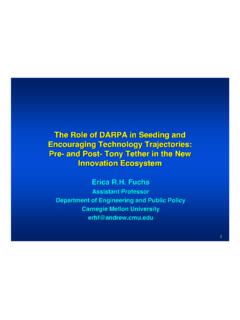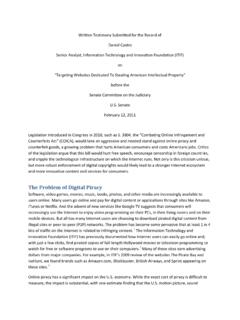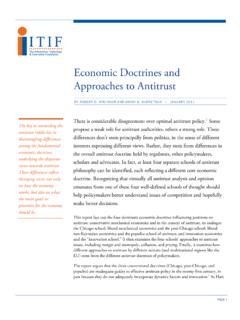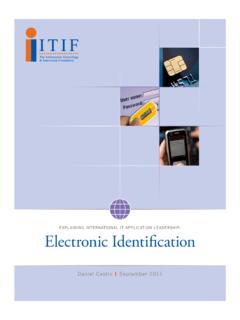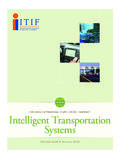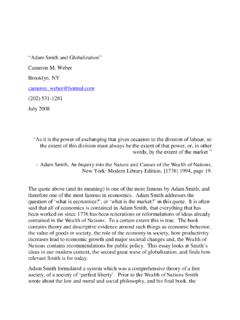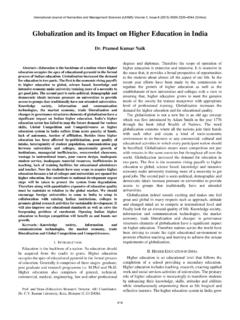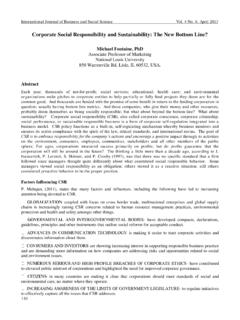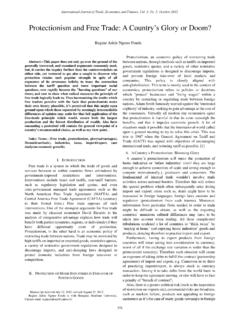Transcription of by RobeRt D. Atkinson AnD DAviD b. AuDRetsch | …
1 The InformaTIon Technology & InnovaTIon foundaTIonITIFThe InformationTechnology& InnovationFoundationPolicymakers and economic scholars around the world agree that the primary source of economic growth, competitiveness, and increases in standards of living in a globalized economy is innovation in the form of new products and services, more efficient production processes, and new business Moreover, as oil and food prices escalate, the need for innovation across the economy becomes even more pressing. Yet even in an election year when both presidential candidates in the United States are confronted with a trou-bled economy, the current political dialogue is giving scant atten-tion to innovation and policies to promote innovative activity. Innovation policy has gotten short shrift in the political dialogue largely be-cause the three dominant economic pol-icy models advocated by most economic advisors and implicitly held by most Washington policymakers ignore the role innovation and technology play in achieving economic growth in the glob-al, knowledge-based economy of the 21st century.
2 Unfortunately, while the economy has been transformed by the forces of technology, globalization, and entrepreneurship, the doctrines guiding economic policymakers have not kept pace and continue to be informed by 20th century conceptualizations, mod-els, and described in this policy brief, the three competing 20th century econom-ics doctrines embraced by most Wash-ington policymakers today are conser-vative neoclassical, liberal neoclassical, and Neo-Keynesian economics doc-trines. One of the most important prin-ciples of neoclassical economics is that it is the accumulation of capital which spurs economic growth. On this point, people in both the conservative and lib-eral neoclassical economics camps agree. But they diverge in the ways they seek to spur capital formation. Conservative neoclassicalists (often called supply-sid-ers) advocate spurring capital formation in the private sector by cutting taxes on by RobeRt D.
3 Atkinson AnD DAvi D b. AuDRetsch | sepTember 2008 While the economy has been transformed by the forces of technolog y, globalization, and entre-preneurship, the doc-trines guiding economic policymakers have not kept pace and continue to be informed by 20th century conceptualiza-tions, models, and Doctrines and Policy Differences: Has the Washington Policy Debate Been Asking the Wrong Questions?pAge 2 The informaTion Technology & innovaTion foundaTion | sepTember 2008 pAge 2 The informaTion Technology & innovaTion foundaTion | income and wealth, whereas liberal neoclassicalists rec-ommend spurring capital formation by having the gov-ernment run budget surpluses (or reduce deficits) and/or by helping low-income people save. Adherents of the third prevailing economics doctrine, neo-Keynes-ianism, stress the importance of both having the fed-eral government ensure aggregate economic demand by increasing government spending and ensuring that the fruits of economic growth are fairly distributed.
4 In his 1776 book, An Inquiry into the Nature and Causes of the Wealth of Nations, Adam Smith argued that there ex-ist three major inputs to the production process: land, labor, and capital. In today s New Economy, a fourth input now significantly outweighs these other three knowledge. The fall of the Berlin Wall in 1989 trig-gered more than just a flat earth, in Tom Friedman s terms; the ensuing globalization accompanied and spurred a shift from the mass production, corporate-managed economy to a knowledge-based entrepre-neurial economy. As leading Stanford economist, Ed Lazear, observed, The entrepreneur is the single most important player in a modern economy. 2 The central goal of economic policy should be to spur higher pro-ductivity and greater be sure, such entrepreneurship does not have to be reflected in individuals starting new companies; it can be reflected in larger organizations acting more nim-bly.
5 But in either case, it is innovation and organiza-tions doing new things that now spurs growth. As innovation and entrepreneurship replace mass-produc-tion and large capital-intensive factories as the engine of growth, jobs, and competitiveness, economic policy must also shift from its old economy concern of stimu-lating consumer demand while restraining the market power of oligopolies to the new economy concern of boosting innovation and productivity. In what has be-come widely known and accepted as the new growth theory, knowledge has been explicitly recognized as a crucial factor generating economic In the new knowledge economy, knowledgeable people, including creative entrepreneurs, skilled shop-floor workers, cutting-edge researchers, innovative manag-ers, and digital-savvy prosumers are the drivers of growth. The keys to growth are in some ways profoundly sim-ple.
6 Nobel Prize-winning economist Douglass North summed it up as follows: We must create incentives for people to invest in more efficient technology, increase their skills, and organize efficient markets. 4 As Paul Romer, former Stanford University economist and a leader in the field of innovation economics, states, the conservative save-more and liberal spend-more approaches are not the answer: [Such] policy prescriptions miss the crux of the matter. Neither adjustments to monetary and fiscal policy, nor increases in the rate of savings and capi-tal accumulation can by themselves generate per-sistent increases in standards of living .. the most important job for economic policy is to create an institutional environment that supports technologi-cal The new realities of a global, knowledge-based econ-omy in the 21st century require a new approach to national economic policy based more on smart sup-port for the building blocks of innovation and entre-preneurship and less on capital accumulation, budget surpluses, or social spending.
7 Without an economic theory and doctrine that match the new realities, it will be very hard for policymakers to take the steps needed to foster economic growth. Fortunately, as described in this policy brief, a new theory and narrative of economic growth based on an explicit effort to understand and model how innova-tion occurs has emerged in the last decade. This new economics doctrine on the block called innovation economics reformulates the traditional model of economic growth so that knowledge, technology, en-trepreneurship, and innovation are positioned at the center of the model rather than seen as independent forces that are largely unaffected by policy. Innovation economics also called new institutional econom-ics, new growth economics, endogenous growth theory, evolutionary economics, and neo-Schump-ertarian economics is based on two fundamental tenets.
8 One is that the central goal of economic policy should be to spur higher productivity and greater inno-vation. Second, markets relying on price signals alone will not always be as effective as smart public-private partnerships in spurring higher productivity and great-er 3 The informaTion Technology & innovaTion foundaTion | sepTember 2008 pAge 3 The informaTion Technology & innovaTion foundaTion | The United States needs an economic framework that supports the new economy and innovation econom-ics is it. Leading economists increasingly acknowledge that without change, the economy cannot grow, that increases in knowledge and competition drive growth and change, and that the government has a key role to play in that process. In short, they are saying that the best macroeconomic policies are institutional policies support for research, innovation, skill build-ing, and digital transformation all within an environ-ment of competitive This policy brief succinctly explains the three prevail-ing economics doctrines, as well as the newer doctrine of innovation economics, that are competing for the attention and allegiance of policymakers.
9 In ad-dition to discussing each doctrine s principles, goals, and what each believes about the economy, it discusses the advantages and limitations of each economics doc-trine. Finally, it examines how each doctrine views particular real-world economic challenges and ex-plains the different types of policy prescriptions that result from : A science oR An ARt?Economics prides itself on being a science, closer to physics than to sociology. But as DAviD Colander notes, the art of economics has been Although supply and demand curves and other aspects of economics do approach being a science, much of economics is actu-ally based on frameworks, paradigms, and doctrines. Thus, noted tax economist Joel Slemrod observes, It is a troubling fact for the aspirations of economics to be a hard science that our values about equity end up being so correlated with our beliefs about what kind of fiscal, or tax policy works best for the economy.
10 8 Lar-ry Lindsey, former head of President Bush s National Economic Council, agrees, noting, In part, the con-tinuing argument [among economists] is a product of philosophical disagreements about human nature and the role of government and cannot be fully resolved by economists no matter how sound their data. 9 People s beliefs about what policy works best for the economy are not simply random thoughts; rather such beliefs make up coherent world views or doctrines, which, in turn, profoundly shape how they view the economy, what they see as important and not impor-tant, and most importantly what they believe is the correct public policy and what is not. Moreover, it s not just economists working at the Federal Reserve, with Congressional committees, or in think tanks that subscribe to particular econom-ics doctrines. Virtually all policymakers involved in economic policy subscribe to a particular econom-ics doctrine, even if they may not be aware of which camp they are in.
